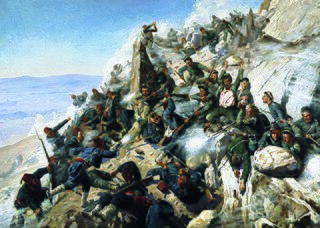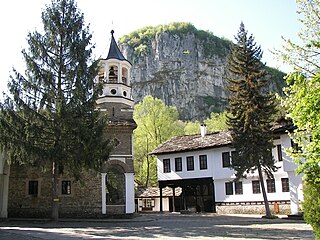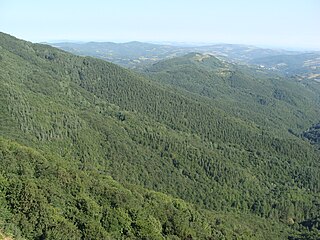Tourism in Bulgaria is a significant contributor to the country's economy. Situated at the crossroads of the East and West, Bulgaria has been home to many civilizations: Thracians, Greeks, Romans, Eastern Romans or Byzantines, Slavs, Bulgars, and Ottomans. The country is rich in tourist sights and historical artifacts, scattered through a relatively small and easily accessible territory. Bulgaria is internationally known for its seaside and winter resorts.

The Monastery of Saint John of Rila, also known as Rila Monastery "Sveti Ivan Rilski", is the largest and most famous Eastern Orthodox monastery in Bulgaria. It is situated in the southwestern Rila Mountains, 117 km (73 mi) south of the capital Sofia in the deep valley of the Rilska River at an elevation of 1,147 m (3,763 ft) above sea level, inside of Rila Monastery Nature Park. The monastery is named after its founder, the hermit Ivan of Rila, and houses around 60 monks.

Gabrovo is a city in central northern Bulgaria, the administrative centre of Gabrovo Province.

Tryavna is a town in central Bulgaria, situated in the northern slopes of the Balkan range, on the Tryavna river valley, near Gabrovo. It is famous for its textile industry and typical National Revival architecture, featuring 140 cultural monuments, must and expositions. Tryavna is the birthplace of Bulgarian writer Pencho Slaveykov and revolutionary Angel Kanchev.

The Battle of Shipka Pass consisted of four battles that were fought between the Russian Empire, aided by Bulgarian volunteers known as opalchentsi, and the Ottoman Empire for control over the vital Shipka Pass during the Russo-Turkish War (1877–1878).

Shipka Pass is a scenic mountain pass through the Balkan Mountains in Bulgaria. It marks the border between Stara Zagora province and Gabrovo province. The pass connects the towns of Gabrovo and Kazanlak. The pass is part of the Bulgarka Nature Park.

The Memorial Temple of the Birth of Christ, better known as the Shipka Memorial Church or Shipka Monastery is a Bulgarian Orthodox church built near the town of Shipka in Stara Planina between 1885 and 1902 to Antoniy Tomishko's design in the seventeenth-century Russian style, under the direction of architect Alexander Pomerantsev. It is, together with the other parts of the Shipka Monument complex, dedicated to the Russian and Bulgarian soldiers that died for the liberation of Bulgaria in the Russo-Turkish War, 1877-78.

The Open Air Ethnographic Museum «Etar» is an open-air museum and a neighbourhood of Gabrovo in northern Bulgaria. It is on the northern edge of the Bulgarka Nature Park, between the park and the city of Gabrovo.

The Dryanovo Monastery is a functioning Bulgarian Orthodox monastery situated in the Andaka River Valley, in Bulgarka Nature Park in the central part of Bulgaria five kilometers away from the town of Dryanovo. It was founded in the 12th century, during the Second Bulgarian Empire, and is dedicated to Archangel Michael. Twice burnt down and pillaged during the Ottoman rule of Bulgaria, the monastery was restored at it present place in 1845. It was the site of several battles during the April Uprising of 1876.
The Liberty Memorial is the symbol of modern Bulgaria and the liberation of Bulgaria. The monument is the heart of the Shipka National Park-Museum and is located on Shipka Peak.

Shipka is a town in central Bulgaria, part of Kazanlak Municipality, Stara Zagora Province. It lies in the Central Balkan Mountains, at 42°42′N25°23′E, 650 metres above sea level. As of 2005, Shipka has a population of 1,398 and the mayor is Stoyan Ivanov.

Maglizh is a town in Stara Zagora Province, South-central Bulgaria. It is the administrative centre of the homonymous Maglizh Municipality. As of December 2009, the town has a population of 3,426 inhabitants.

Joseph Sokolsky was the first senior Eastern Orthodox Bulgarian clergyman to convert to Catholicism, thus becoming a pioneer of the Bulgarian Byzantine Catholic Church. Sokolsky negotiated with Vatican a formal union due to Phanariotes domination over Bulgarian Orthodoxy and gained Catholic recognition in 1861 when Pope Pius IX named him Archbishop for the Bulgarians of the Byzantine Rite. He was also accepted in that capacity by the Ottoman Empire.

The Peshtera Monastery of Saint Nicholas of Myra, also known as the Mraka Monastery or Oryahov Monastery is a medieval Eastern Orthodox monastery in western Bulgaria, located in the Mraka area at the village of Peshtera, near Zemen, Pernik Province. As of 2008, the monastery is not operative.

The Belashtitsa Monastery is a convent in the western Rhodope Mountains near the village of Belashtitsa at 12 km to the south of Plovdiv. It is dedicated to St George the Victorious.

The Doctors' Garden is a park in the Bulgarian capital Sofia between the Oborishte and Shipka streets. It is located behind the SS. Cyril and Methodius National Library and close to many of the historical monuments and state institutions in the capital.

The Bulgarka Natural Park is a Bulgarian nature park on the northern slopes of the Balkan Mountains, occupying 22,000 hectares of territory in the central and eastern part of the mountains between the cities of Gabrovo and Kazanluk.
Buzludzha is a historical peak in the Central Balkan Mountains, Bulgaria. The mountain is located to the east of the Shipka Pass near the town of Kazanlak and is a site of historical importance. The peak is 1,432 metres high. It was renamed to Hadzhi Dimitar in 1942 but remains popularly known as Buzludzha. The summit is limestone and granite. Its slopes are covered with grassy vegetation; its foothills and the neighbouring peaks sustain beech forests. The peak's name derives from Turkish: buzlu 'icy'.























